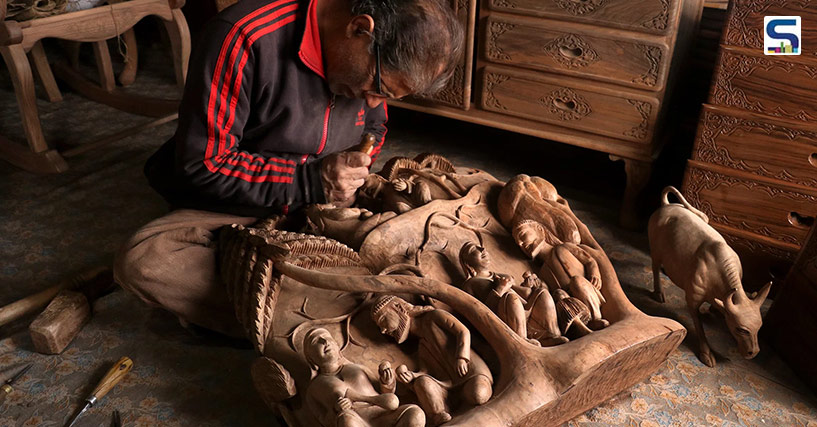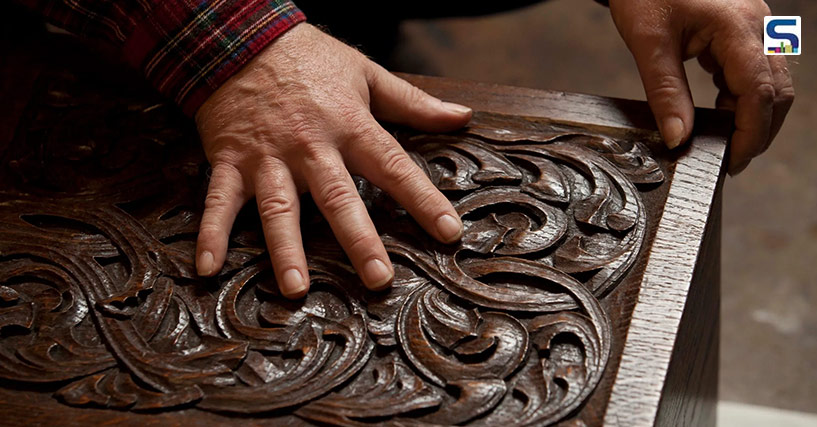
Kashmir is one of the few places where walnut is still grown. Its walnut wood is tough and long-lasting and has a fine grain appeal. Its evenly textured surface makes it suitable for fine and intricate carving work. The carved walnut woodwork is, therefore, one of Kashmir’s finest and most significant crafts.
Kashmiri carvers are known to create visually appealing effects on the polished surfaces of walnut wood with their elaborate and unique designs. Right from dragon themes and Kani designs to rose, lotus and bunches of grapes, pears and chinar leaves, these intricate motifs frequently appear on carved wood. A major part of the state has heavily relied on traditional woodcarving for a living. However, this distinctive heritage is fading due to the unregulated import of wooden objects.
 Image credits: Top: Rethinking The Future; Above: Greater Kashmir
Image credits: Top: Rethinking The Future; Above: Greater Kashmir
Woodcarving has been the worst-hit these days. Gone are the days when Kashmiri carpenters and artists were famed for imprinting distinct designs on wood and decorating homes and old buildings with wooden doors. Today, as consumers prefer pre-made products that are easily accessible in the market, the demand for these traditional items has dropped to its lowest. Local artists observed that earlier there was a high demand for woodcarving products not only within the state but also from the neighbouring states. However, the time has changed.
Artists believe other than these factors, lack of development in the art of woodcarving has also led to its fall. Kashmiri artists, who are associated with woodcarving, are suffering the most with unemployment hitting its peak in the state, where even age-old family-run woodcarving businesses are severely affected, especially when GST had been imposed in the region. Reportedly, local artists used to get orders from New Delhi, Kolkata, Bengaluru, etc, but of late, they hardly receive such orders. That said, even international shipping has been privatized massively over the past four years.
Previously, customers would receive a hand-carved wooden door at Rs 4,500, whereas today, the same door is being sold for nearly Rs 8,500. It is difficult for a common man to afford such a product, thereby leading to the downfall of the woodcarving sector in Kashmir. Kashmiri artists strongly believe that the demand for locally manufactured wood-carved objects has declined significantly due to importing wooden goods made out of foreign timber, which is also cheaper than local items.
700-800 cubic feet of curved wood were being sold to the customers before the abrogation of Article 370. The cost has now doubled to Rs 1,200, which commoners cannot afford. Not only cheaper than the finely crafted local products, but these imported wooden items are also being imprinted by machines in bulk.
The sector is missing the support and workforce to keep the traditional woodcarving alive. Budding artisans have refrained from showing concern towards woodcarving as they find the trade a non-profitable one, thereby further affecting the trade. Not only have local artisans lacked a platform to display their wares, but what appears now is that outsiders (non-locals) have also started their woodcarving business in the state. The Forest Department of Jammu and Kashmir issues license to the citizen of Kashmir for running woodcarving shops. Such woodcarving shops by the non-locals have affected the trade of locals.
 Image credits: Ruelle
Image credits: Ruelle
Furthermore, reports suggest that woodcarving artisans throughout the valley were not receiving enough walnut products from the locals. Walnut trees were primarily used for woodcarving in Kashmir. The Jammu and Kashmir Preservation of Specified Trees Act, 1969 imposed a ban on cutting walnut trees. As per the act, one can neither cut the walnut trees nor prune. Permission is required from the revenue officials to cut down a walnut tree, which is a time-consuming process. This directly affected the livelihood of local artisans. However, the horticulture department of Kashmir has requested to lift the restriction on cutting down walnut trees in the Kashmir Valley.
The changes in need and market demand are already affecting the 600-year-old traditional art and in the years to come, Kashmir might lose walnut woodcarving. It is the need of the hour for the artisans and the government to come together and develop new and eye-catching designs and techniques to revive this trade which can attract foreign tourists as well.
Last year, Srinagar had been added to UNESCO’s coveted list of Crafts and Folk Arts for 2021. This act reaffirmed the faith of local artisans in the dying art. That said, the move is expected to aid in the revival of walnut woodcarving.